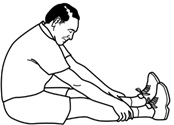
Information about Yoga For Lower Back Pain
Developed in India, the ‘modern’ form probably dates back around 2000 years. The benefits are legion and positively influence metabolic, musculoskeletal, and mental health.
The influence on musculoskeletal health is evident.
Without a regular stretching program, muscles tighten up and move bones out of alignment. If you knew anything about stretching, as soon as you experience a spasm somewhere, you’d know that you needed to start stretching and getting your skeleton back into better alignment.
The good thing about yoga is that it treats the body as a total musculoskeletal ecosystem. The progression of exercises through an hour-long yoga session is designed to treat the skeleton as a whole. It recognizes that the best way to treat a part of the skeleton is to treat the whole of it—not just a couple of stretches near the site of the pain.
My mother used to say, ‘Look after the pennies, and the pounds will look after themselves.’ Regarding musculoskeletal health, ‘Look after your skeleton and the parts will look after themselves.’
For example, lower back pain is a symptom of a system problem, not just a lower back problem. It highlights the need to get the whole skeleton back into better alignment.
Western medicine has broken the body into parts. Ie, if you have a sore back the cause of the problem must be at the site of the pain!
With this in mind, the medical and associated white-coat industries focus on ‘attacking’ the site of the pain, X-raying it, pummelling it, crunching it, and, if the worst comes to the worst, lacerating it.
However, it doesn’t work like that. When it comes to lower back pain, the likelihood that the cause of the problem is at the site of the pain is quite remote. It’s a system problem that has to be fixed ‘systematically’.
Yoga does that. Yoga For Lower Back Pain involves a general set of exercises directed at loosening muscles throughout your body, resulting in the gradual alignment of the skeleton.
This principle recognizes that tight muscles cause the skeleton to be out of alignment. Suppose you live in a sedentary, sit-down culture and don’t have a stretching program. In that case, muscles around the body will inevitably gradually tighten up and draw bones out of alignment.
With lower back pain, it’s usually muscles attached to the pelvis that have tightened up and taken it out of alignment.
One of the great tragedies of modern medicine is that yoga is not taught in medical school. Another tragedy is that doctors don’t give their clients with back pain a prescription to see a yoga teacher—or even a list of stretching exercises.
On the other hand, doctors have no problem doling out a prescription to collect a dose of pain masking medicine from the chemist. But it’s a third-rate form of therapy that prescribes a pill without also prescribing a suite of stretching exercises.
When it comes to back pain, generally, there is a whopping big black hole in community knowledge about the cause, prevention and treatment. There’s something wrong with a school system from which students graduate without knowing how to prevent the most common, personally generated body system dysfunction.
Schools could do much worse than having a daily yoga session to get students off their mobile phones, quiet them down and loosen them off.
At Global Back Care, we’ve embraced the philosophy generated by old yoga practitioners. We’ve picked out a specific selection of stretching exercises we know well – for most people – to get their skeletons back into better alignment.
But having said that, yoga supplies us with the gold standard of exercises for musculoskeletal health and the inner peacefulness that comes with it.
In the meantime, stay tuned, as Hamlet might have said to Ophelia, ‘Get thee to a yoga studio’.
John Miller
